Weiyu Guo
Logic-in-Frames: Dynamic Keyframe Search via Visual Semantic-Logical Verification for Long Video Understanding
Mar 17, 2025Abstract:Understanding long video content is a complex endeavor that often relies on densely sampled frame captions or end-to-end feature selectors, yet these techniques commonly overlook the logical relationships between textual queries and visual elements. In practice, computational constraints necessitate coarse frame subsampling, a challenge analogous to ``finding a needle in a haystack.'' To address this issue, we introduce a semantics-driven search framework that reformulates keyframe selection under the paradigm of Visual Semantic-Logical Search. Specifically, we systematically define four fundamental logical dependencies: 1) spatial co-occurrence, 2) temporal proximity, 3) attribute dependency, and 4) causal order. These relations dynamically update frame sampling distributions through an iterative refinement process, enabling context-aware identification of semantically critical frames tailored to specific query requirements. Our method establishes new SOTA performance on the manually annotated benchmark in key-frame selection metrics. Furthermore, when applied to downstream video question-answering tasks, the proposed approach demonstrates the best performance gains over existing methods on LongVideoBench and Video-MME, validating its effectiveness in bridging the logical gap between textual queries and visual-temporal reasoning. The code will be publicly available.
SEE: See Everything Every Time -- Adaptive Brightness Adjustment for Broad Light Range Images via Events
Feb 28, 2025Abstract:Event cameras, with a high dynamic range exceeding $120dB$, significantly outperform traditional embedded cameras, robustly recording detailed changing information under various lighting conditions, including both low- and high-light situations. However, recent research on utilizing event data has primarily focused on low-light image enhancement, neglecting image enhancement and brightness adjustment across a broader range of lighting conditions, such as normal or high illumination. Based on this, we propose a novel research question: how to employ events to enhance and adaptively adjust the brightness of images captured under broad lighting conditions? To investigate this question, we first collected a new dataset, SEE-600K, consisting of 610,126 images and corresponding events across 202 scenarios, each featuring an average of four lighting conditions with over a 1000-fold variation in illumination. Subsequently, we propose a framework that effectively utilizes events to smoothly adjust image brightness through the use of prompts. Our framework captures color through sensor patterns, uses cross-attention to model events as a brightness dictionary, and adjusts the image's dynamic range to form a broad light-range representation (BLR), which is then decoded at the pixel level based on the brightness prompt. Experimental results demonstrate that our method not only performs well on the low-light enhancement dataset but also shows robust performance on broader light-range image enhancement using the SEE-600K dataset. Additionally, our approach enables pixel-level brightness adjustment, providing flexibility for post-processing and inspiring more imaging applications. The dataset and source code are publicly available at:https://github.com/yunfanLu/SEE.
A Survey of fMRI to Image Reconstruction
Feb 24, 2025Abstract:Functional magnetic resonance imaging (fMRI) based image reconstruction plays a pivotal role in decoding human perception, with applications in neuroscience and brain-computer interfaces. While recent advancements in deep learning and large-scale datasets have driven progress, challenges such as data scarcity, cross-subject variability, and low semantic consistency persist. To address these issues, we introduce the concept of fMRI-to-Image Learning (fMRI2Image) and present the first systematic review in this field. This review highlights key challenges, categorizes methodologies such as fMRI signal encoding, feature mapping, and image generator. Finally, promising research directions are proposed to advance this emerging frontier, providing a reference for future studies.
SpGesture: Source-Free Domain-adaptive sEMG-based Gesture Recognition with Jaccard Attentive Spiking Neural Network
May 23, 2024



Abstract:Surface electromyography (sEMG) based gesture recognition offers a natural and intuitive interaction modality for wearable devices. Despite significant advancements in sEMG-based gesture-recognition models, existing methods often suffer from high computational latency and increased energy consumption. Additionally, the inherent instability of sEMG signals, combined with their sensitivity to distribution shifts in real-world settings, compromises model robustness. To tackle these challenges, we propose a novel SpGesture framework based on Spiking Neural Networks, which possesses several unique merits compared with existing methods: (1) Robustness: By utilizing membrane potential as a memory list, we pioneer the introduction of Source-Free Domain Adaptation into SNN for the first time. This enables SpGesture to mitigate the accuracy degradation caused by distribution shifts. (2) High Accuracy: With a novel Spiking Jaccard Attention, SpGesture enhances the SNNs' ability to represent sEMG features, leading to a notable rise in system accuracy. To validate SpGesture's performance, we collected a new sEMG gesture dataset which has different forearm postures, where SpGesture achieved the highest accuracy among the baselines ($89.26\%$). Moreover, the actual deployment on the CPU demonstrated a system latency below 100ms, well within real-time requirements. This impressive performance showcases SpGesture's potential to enhance the applicability of sEMG in real-world scenarios. The code is available at https://anonymous.4open.science/r/SpGesture.
MIPI 2024 Challenge on Demosaic for HybridEVS Camera: Methods and Results
May 08, 2024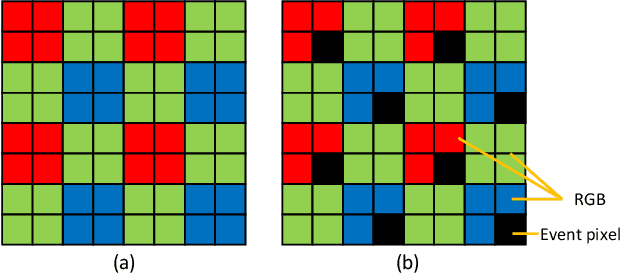
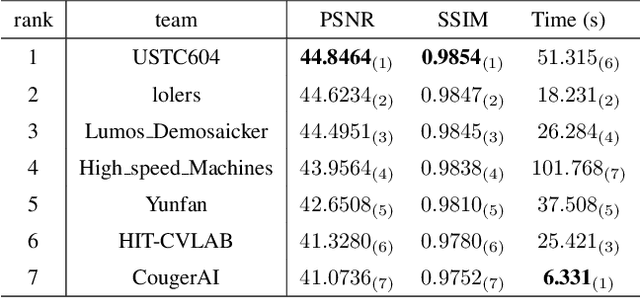


Abstract:The increasing demand for computational photography and imaging on mobile platforms has led to the widespread development and integration of advanced image sensors with novel algorithms in camera systems. However, the scarcity of high-quality data for research and the rare opportunity for in-depth exchange of views from industry and academia constrain the development of mobile intelligent photography and imaging (MIPI). Building on the achievements of the previous MIPI Workshops held at ECCV 2022 and CVPR 2023, we introduce our third MIPI challenge including three tracks focusing on novel image sensors and imaging algorithms. In this paper, we summarize and review the Nighttime Flare Removal track on MIPI 2024. In total, 170 participants were successfully registered, and 14 teams submitted results in the final testing phase. The developed solutions in this challenge achieved state-of-the-art performance on Nighttime Flare Removal. More details of this challenge and the link to the dataset can be found at https://mipi-challenge.org/MIPI2024/.
Revisiting Noise Resilience Strategies in Gesture Recognition: Short-Term Enhancement in Surface Electromyographic Signal Analysis
Apr 17, 2024Abstract:Gesture recognition based on surface electromyography (sEMG) has been gaining importance in many 3D Interactive Scenes. However, sEMG is easily influenced by various forms of noise in real-world environments, leading to challenges in providing long-term stable interactions through sEMG. Existing methods often struggle to enhance model noise resilience through various predefined data augmentation techniques. In this work, we revisit the problem from a short term enhancement perspective to improve precision and robustness against various common noisy scenarios with learnable denoise using sEMG intrinsic pattern information and sliding-window attention. We propose a Short Term Enhancement Module(STEM) which can be easily integrated with various models. STEM offers several benefits: 1) Learnable denoise, enabling noise reduction without manual data augmentation; 2) Scalability, adaptable to various models; and 3) Cost-effectiveness, achieving short-term enhancement through minimal weight-sharing in an efficient attention mechanism. In particular, we incorporate STEM into a transformer, creating the Short Term Enhanced Transformer (STET). Compared with best-competing approaches, the impact of noise on STET is reduced by more than 20%. We also report promising results on both classification and regression datasets and demonstrate that STEM generalizes across different gesture recognition tasks.
Event Camera Demosaicing via Swin Transformer and Pixel-focus Loss
Apr 03, 2024Abstract:Recent research has highlighted improvements in high-quality imaging guided by event cameras, with most of these efforts concentrating on the RGB domain. However, these advancements frequently neglect the unique challenges introduced by the inherent flaws in the sensor design of event cameras in the RAW domain. Specifically, this sensor design results in the partial loss of pixel values, posing new challenges for RAW domain processes like demosaicing. The challenge intensifies as most research in the RAW domain is based on the premise that each pixel contains a value, making the straightforward adaptation of these methods to event camera demosaicing problematic. To end this, we present a Swin-Transformer-based backbone and a pixel-focus loss function for demosaicing with missing pixel values in RAW domain processing. Our core motivation is to refine a general and widely applicable foundational model from the RGB domain for RAW domain processing, thereby broadening the model's applicability within the entire imaging process. Our method harnesses multi-scale processing and space-to-depth techniques to ensure efficiency and reduce computing complexity. We also proposed the Pixel-focus Loss function for network fine-tuning to improve network convergence based on our discovery of a long-tailed distribution in training loss. Our method has undergone validation on the MIPI Demosaic Challenge dataset, with subsequent analytical experimentation confirming its efficacy. All code and trained models are released here: https://github.com/yunfanLu/ev-demosaic
Explainable Enterprise Credit Rating via Deep Feature Crossing Network
May 22, 2021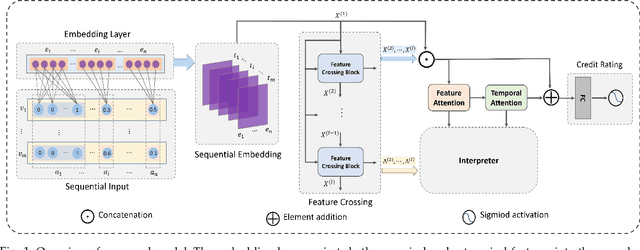
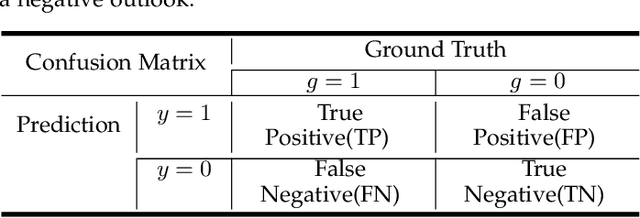
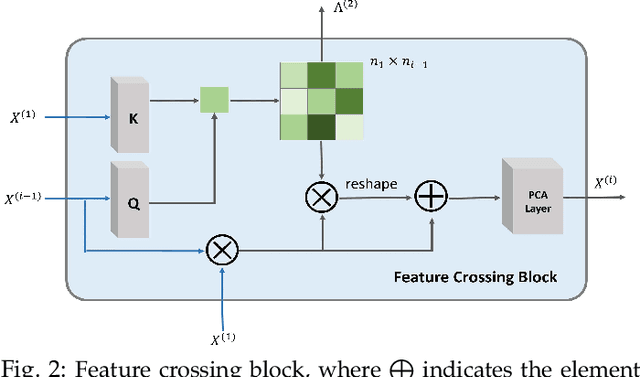

Abstract:Due to the powerful learning ability on high-rank and non-linear features, deep neural networks (DNNs) are being applied to data mining and machine learning in various fields, and exhibit higher discrimination performance than conventional methods. However, the applications based on DNNs are rare in enterprise credit rating tasks because most of DNNs employ the "end-to-end" learning paradigm, which outputs the high-rank representations of objects and predictive results without any explanations. Thus, users in the financial industry cannot understand how these high-rank representations are generated, what do they mean and what relations exist with the raw inputs. Then users cannot determine whether the predictions provided by DNNs are reliable, and not trust the predictions providing by such "black box" models. Therefore, in this paper, we propose a novel network to explicitly model the enterprise credit rating problem using DNNs and attention mechanisms. The proposed model realizes explainable enterprise credit ratings. Experimental results obtained on real-world enterprise datasets verify that the proposed approach achieves higher performance than conventional methods, and provides insights into individual rating results and the reliability of model training.
Robust Learning with Frequency Domain Regularization
Jul 07, 2020



Abstract:Convolution neural networks have achieved remarkable performance in many tasks of computing vision. However, CNN tends to bias to low frequency components. They prioritize capturing low frequency patterns which lead them fail when suffering from application scenario transformation. While adversarial example implies the model is very sensitive to high frequency perturbations. In this paper, we introduce a new regularization method by constraining the frequency spectra of the filter of the model. Different from band-limit training, our method considers the valid frequency range probably entangles in different layers rather than continuous and trains the valid frequency range end-to-end by backpropagation. We demonstrate the effectiveness of our regularization by (1) defensing to adversarial perturbations; (2) reducing the generalization gap in different architecture; (3) improving the generalization ability in transfer learning scenario without fine-tune.
Learning Efficient Convolutional Networks through Irregular Convolutional Kernels
Sep 29, 2019



Abstract:As deep neural networks are increasingly used in applications suited for low-power devices, a fundamental dilemma becomes apparent: the trend is to grow models to absorb increasing data that gives rise to memory intensive; however low-power devices are designed with very limited memory that can not store large models. Parameters pruning is critical for deep model deployment on low-power devices. Existing efforts mainly focus on designing highly efficient structures or pruning redundant connections for networks. They are usually sensitive to the tasks or relay on dedicated and expensive hashing storage strategies. In this work, we introduce a novel approach for achieving a lightweight model from the views of reconstructing the structure of convolutional kernels and efficient storage. Our approach transforms a traditional square convolution kernel to line segments, and automatically learn a proper strategy for equipping these line segments to model diverse features. The experimental results indicate that our approach can massively reduce the number of parameters (pruned 69% on DenseNet-40) and calculations (pruned 59% on DenseNet-40) while maintaining acceptable performance (only lose less than 2% accuracy).
 Add to Chrome
Add to Chrome Add to Firefox
Add to Firefox Add to Edge
Add to Edge